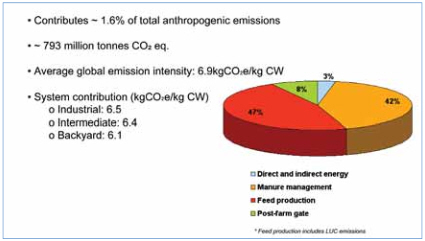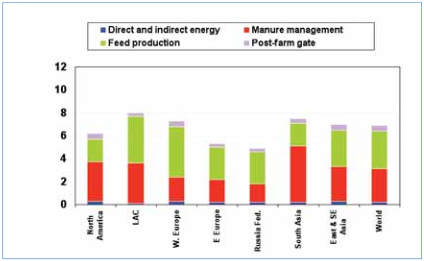



Pigs and the Environment
An assessment by the British Pig Executive (BPEX) of the impact of pork production on greenhouse gas (GHG) emissions and how the sector is reducing its impact in China, USA, Canada, Brazil, Denmark, France, Germany, Hungary, Ireland, Netherlands, Spain, Sweden, United Kingdom, Russia, Australia and New Zealand.Global Impact of Pork Production and Processing on GHG Emissions
Pork, in all its various forms, is the worlds most popular meat. In 2009, it accounted for 38 per cent of all meat consumed on the planet. Consumption is forecast to grow and although poultry meat may eventually take a greater market share, by 2050, pork consumption is forecast to reach 144 million tonnes (FAO), 40 per cent higher than in 2009.
The driving factors behind this are well recognised. By 2050, there are expected to be 30 per cent more people alive on the planet. Many are expected to have higher real incomes and be predominantly living in urban areas. Their demand for food is expected to evolve, with a greater demand for meat.
These trends will bring challenges to the whole of livestock farming and the way it impacts on the world. At the present time, livestock production accounts for 35 per cent of all arable land for feed, eight per cent of all freshwater and approximately 18 per cent of climate gas emissions. It also provides 13 per cent of all calories, 25 per cent of all protein, 1.5 per cent of world GDP and is a central component in the livelihood of one billion people.
Impact of Pork Production on GHG Emissions
Pork production and processing impact on the environment in a number of ways. While tackling Green House Gas emissions is considered the priority there are other factors that are being addressed. These include eutrophication from the leaking of nutrients into the ecosystem, acidification resulting from acidic gases such as ammonia reacting with water in the atmosphere, abiotic resource depletion which impacts on the availability of finite resources such as fossil fuels and potential local water availability issues arising from irrigated food crops.
The nature of pork production and processing is changing in line with changing consumers and the competitive pressures on the market. The scale of production has generally increased as producers seek greater efficiency. In North and South America and parts of Asia, this has been driven by increased vertical integration and organisation in the supply chain. In Europe, there has been greater specialisation and co-operation among producers, while in Russia and China restructuring and modernisation is being driven greatly by government policy.
The drive for greater efficiency is also being facilitated by improvements and uptake of technology, especially in pig breeding and the increased availability and trading of feed, especially vegetable proteins such as soybeans.
The GHGs associated with pork production are emissions of ammonia, nitrous oxide and methane. Together with a lesser amount of direct carbon dioxide, these are combined into a single carbon dioxide-equivalent figure (CO2eq).
Provisional estimates from FAO indicate that pork production contributes about 793 million tonnes CO2eq, which represents approximately 1.6 per cent of global GHG emissions. This gives an average global emission intensity of about 6.9kg CO2eq per kg carcass weight which is relatively low impact. The analysis also indicates that the vast majority of global emissions result from manure management (42 per cent) and feed production (47 per cent), see Figure 1.

(Source: FAO)
These calculations include an element of emissions attributed to feed that come from the estimated impact of Land Use Change (LUC). In particular, this relates to the production of soy in South America which is claimed to be grown on land that is either directly or indirectly linked to deforestation. This LUC effect attributed to pig production, mostly in Western Europe and to a lesser extent in South America and Asia, is estimated at 1,289 million tonnes CO2eq. The effect on global emission intensity is approximately 1.1kg CO2eq kg carcass weight (cw) which would reduce average global emission intensity from pork production to about 5.8kg CO2eq kg cw if excluded.
The attribution of LUC to meat production through feed is still the subject of considerable debate. It seems to be accepted that the amount of soy grown in cleared rainforest areas is relatively small and that the voluntary moratorium on the sourcing of soy from the deforested areas, introduced in 2006, indicate that soy’s role as an agent of deforestation has diminished greatly as a result.
The emission intensity of pork production as assessed by FAO shows a relatively similar pattern in the worlds main producing regions. Taking the global average of 6.9kg CO2eq per kg cw than the regional variation is very modest, in a range from about 5 to 8kg CO2eq kg cw.

(Source: FAO)

(Source: FAO)
Future Direction
The FAO analysis clearly indicates where the priority areas are for future action.
Although pork production and processing have a relatively low carbon footprint, its position as a leading source of global meat consumption means it can make a significant contribution to managing GHG emissions.
Efficiency of production is rising as both developed and developing countries embrace new technologies and management methods and so the pork production and processing industry has the capability of producing more output with less inputs.
Feed accounts for nearly half of the pork production footprint on a global basis (even higher in many countries) so any gains in the efficiency of feed production (minimum tillage, precision farming, tailored varieties) or access to new feed sources (DDGS from ethanol) will have a direct impact on the carbon footprint of pork production.
Manure management is the other large contributor to carbon footprint. There are already examples that can be developed where manure is not only being managed to minimise environmental impact, it is also being used to maximise energy generation and replace artificial fertilisers.
This report presents an overview of the global impact that pig production has on the environment and specifically the emission of Green House Gases. It uses provisional data produced by Food and Agriculture Organisation (FAO) of the United Nations. This data will be updated in the coming years as new knowledge becomes available.
The report also contains examples of measures being taken in individual countries to reduce the impact on the environment in the future. These countries collectively account for 78 per cent of the world’s pork production. There are a broad range of measures outlined including more efficient use of feed, water saving, manure handling and storage and bioenergy generation. More detail is available by following the links in the text in the full report.
June 2012








